1995 $20 Dollar Bill Value: How Much Is It Worth Today?
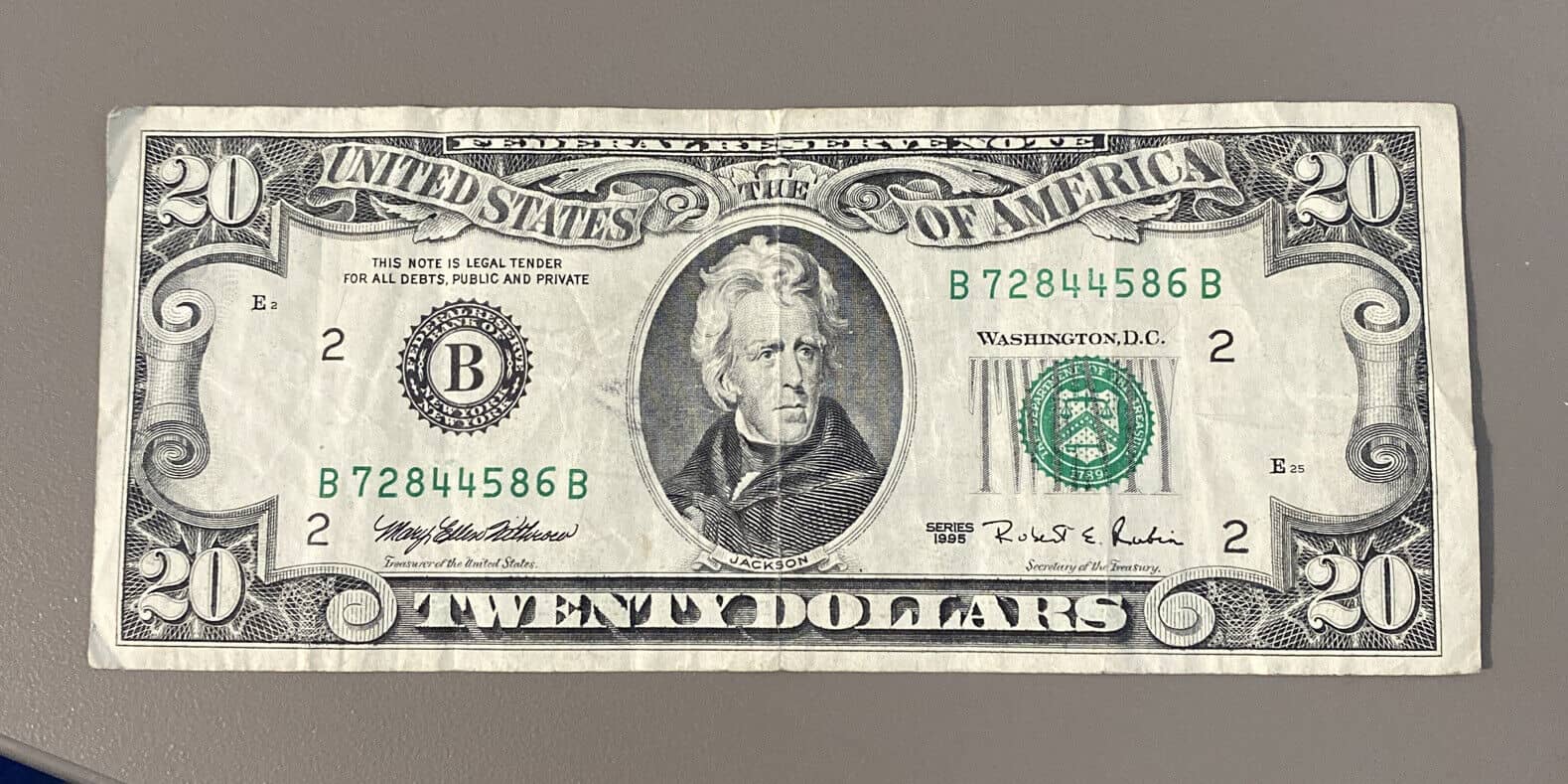
The 1995 $20 Bill was the last one that featured the small note design introduced in 1928. After this 1995 Series, the front and back changed significantly for the 1996 Series. This makes the 1995 $20 Bill an important one for numismatists (people who study, collect, and trade coins, medals, tokens, and paper money). So let’s explore the 1995 20 Dollar Bill Value.
1995 20 Dollar Bill Price Tables
While most 1995 $20 Bills are evaluated by their rarity and condition, the serial number is a big criterion. Fancy serial numbers like solids (e.g. 33333333) and ladders (e.g. 23456789) can fetch a lot more money. You can also check for repeating numbers, extremely low serial numbers (e.g. 00000007), and higher ones that begin with 9. Below are a few top examples.
1995 20 Dollar Bill Value Chart |
||||
| $20 Bill Series | District/Branch | Date of Sale | Grade | Price |
| Fr. 2081-D 1995 $20
Solid #1s Serial Number |
Cleveland | 25th August 2023 | 64 PPQ Choice Uncirculated | $1,920 |
| Fr. 2082-L 1995 $20 Solid #4s Serial Number | San Francisco | 13th April 2023 | 66 EPQ Gem Uncirculated | $1,380 |
| Fr. 2082-K 1995 $20
Serial Number #1 |
Dallas | 19th March 2013 | 64 EPQ Choice Uncirculated | $5,287.50 |
History of the 1995 20 Dollar Bill
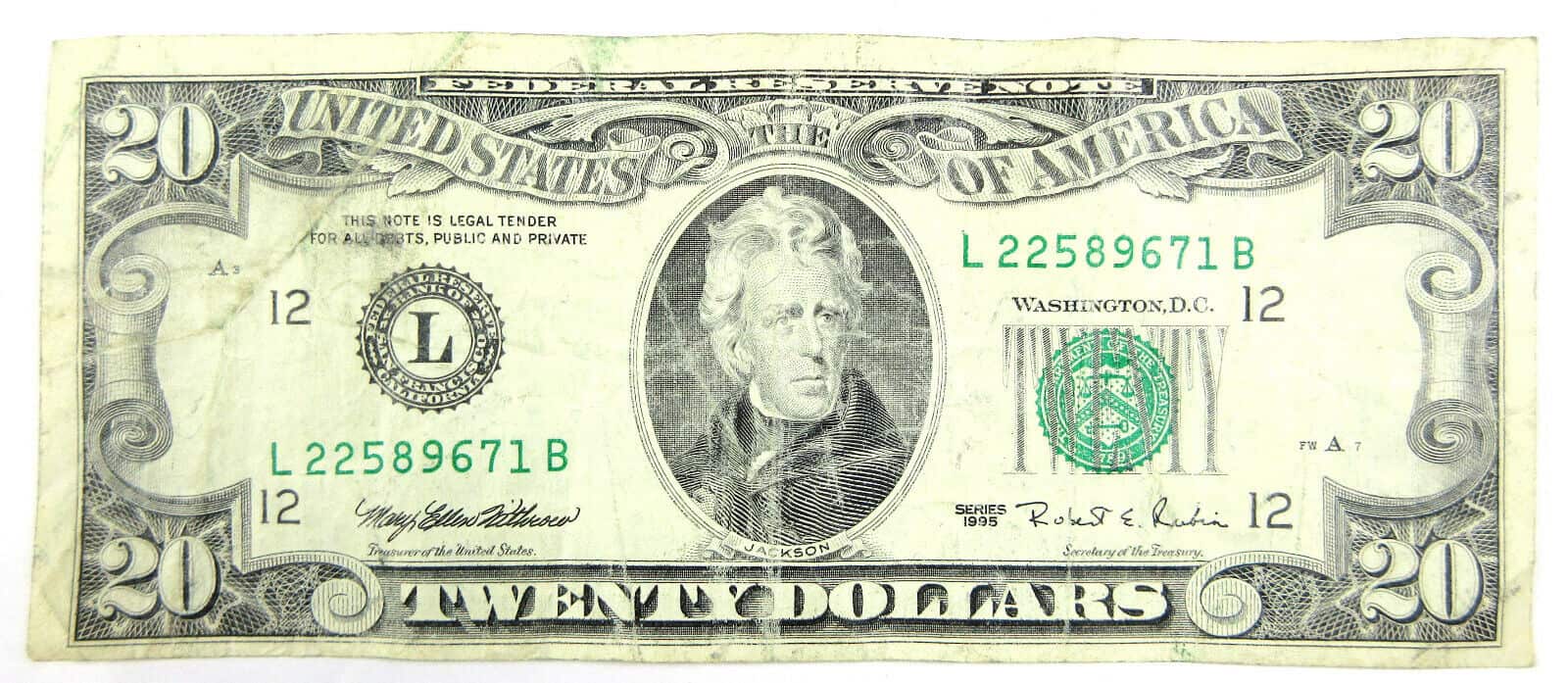
Americans use $20 Bills every day. But we don’t understand their history. Most of us don’t even know who’s on them! His name is Andrew Jackson, and he was the 7th US President. Although he was one of the Founding Fathers, his placement on the $20 Bill was sort of a practical joke or petty protest. After all, he didn’t believe in federal banks or paper money.
Curiously, there was a push to replace him with Harriet Tubman in twenteens (2013 to 2019) but there was a lot of controversy around the decision. While the public loved the idea, it was bureaucratically squashed and is unlikely to be implemented before 2030. But let’s get back to Jackson. He’s known for clearing all US debt during his presidency, which was quite a feat.
In fact, he was the only president that ever managed it! And on a lighter note, when political opponents called him a jackass, he laughed at the insult, embraced it, and adopted a donkey as the official symbol of his Democratic Party. But he had some bad elements as well. Like most of the Founding Fathers and successful men at the time, he owned hundreds of slaves.
Jackson’s History with Minorities
On a broader scale, he passed the Indian Removal Act that evicted Native Americans from their vast ancestral lands and forced them into reservations, killing thousands in the process. About one-third of their descendants still live in those regions today, and it has drastically affected their culture, economic status, and equitable access to progress and opportunities.
The $20 Bill is probably the most circulated American bank note. It could also be taken as a representative of the US Presidency since it has the White House on the back. In the past, it existed as both a gold certificate and a silver certificate. This means you could take a $20 Bill to the bank and exchange it for gold or silver. Also, it featured lots of people before Jackson.
These included Grover Cleveland, James Garfield, Alexander Hamilton, Stephen Decatur, George Washington, and even Pocahontas! But from 1928, Andrew Jackson secured his spot on the note and he’s still on it today. That design hasn’t changed much except for the color of the seal and multiple anti-counterfeiting features that have been enhanced over the years.
Protecting the $20 Bill from Fraudsters
The security measures on the $20 Bill included watermarks, micro-printing, color-changing ink, and plastic UV-A ribbons. Newer notes also have special fonts for the visually impaired. As its series year implies, the 1995 $20 Bill was first approved in 1995. With bank notes, the series date can be re-used for several years until a new design is selected and implemented.
That said, the 1995 Series of $20 didn’t last long before the 1996 Series was introduced. This was because lots of people were faking the note so the BEP – the Bureau of Engraving and Printing – had to revamp it and add the security elements we mentioned earlier. It was the first overhaul since 1929 and included a larger portrait and a north view of the White House.
For reference, the 1995 Series $20 shows the south view of the White House. Interestingly, the 1996 Series was approved in 1996 but wasn’t printed until June 1998. It took that long to effectively implement all that security tech. Similarly, the 1990 Series (which was the first bank note with built-in anti-counterfeiting features), wasn’t in circulation until April 1992.
Features of the 1995 20 Dollar Bill
In describing the features of a bank note, the front or heads side is technically referred to as the obverse while the back is the reverse. The images, portraits, or pictures are devices while the background is the field. The words are known as legends or mottos. Bank notes are made by rolling an impression cylinder over a face plate (for the obverse) and a back plate (reverse).
They’re printed as uncut sheets of 24 to 50 notes that are later sliced into individual notes, so every note has a code that marks its position on the uncut sheet. Beyond that, bank notes are designated A to H and 1 to 12 to identify Federal Reserve Bank Districts or Branches. Some of these districts are more valuable than others so $20 Bills must carry all this information.
The Obverse of the 1995 20 Dollar Bill
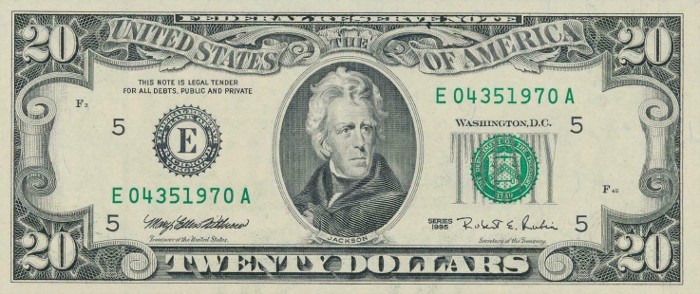
It shows Andrew Jackson with his name under his portrait. He is flanked by two signatories, two serial numbers, four district numbers, and two seals – Treasury on the right and District on the left. The legal tender statement is on the upper left while the right has Twenty spelled out and Washington DC. The numeral 20 is on the four outermost corners of this bank note.
The upper right has a letter-number combo that shows the face plate position while the lower right has a similar or sometimes identical figure indicating the face plate number. The series year is on the right of the portrait. The top of the note says Federal Reserve Note and The United States of America with ‘the’ placed above the device. The bottom says Twenty Dollars.
The Reverse of the 1995 20 Dollar Bill
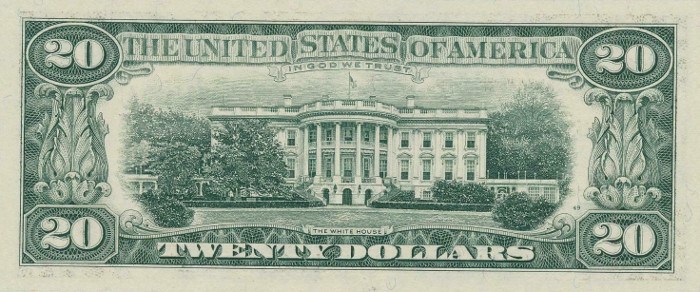
It shows the southern view of the White House, with The United States of America and In God We Trust at the top of the note. The bottom of the note says The White House followed by Twenty Dollars. The four outer corners of the note show the denomination 20 in number form. The inner bottom right has a tiny number that identifies the back plate used for the $20.
Other Features of the 1995 20 Dollar Bill
Like all $20 Bills, the 1995 Series is 75% Linen and 25% Cotton. It weighs slightly under a gram and measures 156mm by 66.3mm. All 1995 $20 Bills were signed by Secretary Robert Edward Rubin and Treasurer Mary Ellen Hinamon Withrow. The Treasurer’s signature is on the lower left of the device while the Secretary’s signature sits on the lower right of the note.
1995 20 Dollar Bill Value Guides
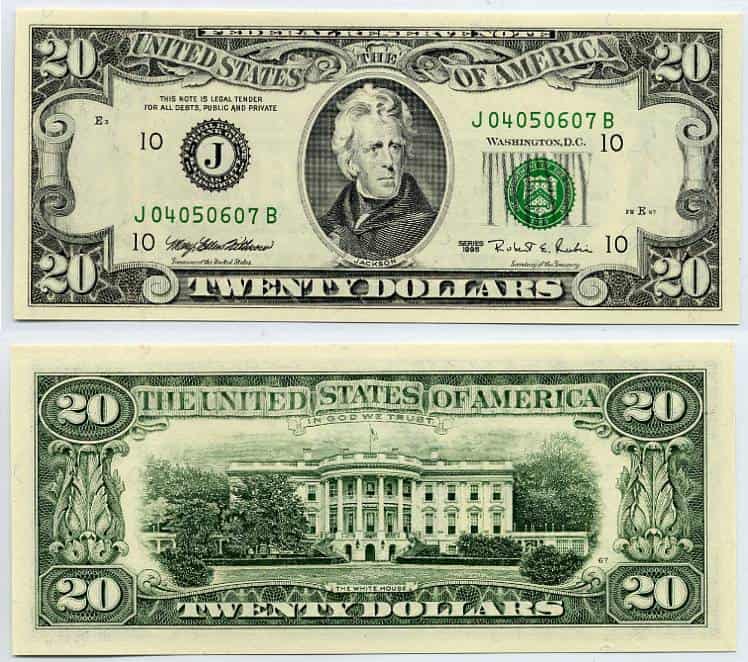
As we mentioned earlier, the district of a $20 Bill can affect its resale price. In the US, we only print bank notes in Washington DC or Fort Worth, Texas. Notes that are made in Fort Worth have FW before the lower right face plate number. Other factors that affect the 1995 20 Dollar Bill value include the condition of the note and any mint mistakes it might have.
On 1995 $20 Bills, the District Seal has a letter inside the circle. This same letter starts the serial number. But on older notes, the District Seal sometimes has a number instead of a letter. And on newer notes, the serial number starts with two letters – one representing the series year and the second showing the district. Let’s look at recent 1995 $20 Bill Values.
1995 $20 Bill Value
Most $20 Bills from 1995 are Fr. 2081 and Fr. 2082. The Fr. is for Robert Friedberg. His book Paper Money of the United States has a list of all circulating American bank notes, assigning them each a Friedberg Number. As we mentioned before, the 1995 $20 was signed by Withrow and Rubin. On 25th August 2023, a special Fr. 2081-D 1995 $20 sold for $1,920.
It has solid serial numbers and was graded Choice 64 PPQ. But because the district makes a difference, a San Francisco $20 Bill sold for less despite having a higher grade. It was also a solid serial number note, but this Fr. 2082-L graded Gem Uncirculated EPQ 66 sold for $1,380 on 13th April 2023. But one year earlier, a Fr. 2082-L graded 65 PPQ was just $336.
Its serial number was #70000007, so not all the fancy ones are equal. Notably, the #1 note is the most sought after (i.e. #00000001). Ten years ago, a Fr. 2082-K 1995 $20 Serial Number #1 sold for $5,287.50 on 19th April 2013. But you can get good money for any serial number under #99 so hold on to those. Also, sell complete batches e.g. Boston to San Francisco #33.
1995 20 Dollar Bill Grading
The terms used to grade paper money are similar to coins since they’re both based on the Sheldon Scale. It goes from 1 to 70, with the lowest quality described as Poor and the highest as Superb Gem Uncirculated. Top notes are also marked as EPQ or PPQ. We’ve talked a lot about the security features on $20 Bills. Check them carefully to ensure your $20 isn’t a fake.
1995 20 Dollar Bill Errors List
If your $20 Bill has an error from the mint, it could be worth a lot of money. So it helps to be familiar with the most common mint mistakes and search for them in your bank notes. You can also order bank straps and inspect them for flaws. It’s not a waste since you can always send the normal notes back. But if you’re lucky, you might find a $20 Bill worth thousands!
To understand mint mistakes, it helps to know that paper money is printed in three swipes. The first is the back, the second is the front, and the third is the overprint, which adds the colored serial numbers and seals to the obverse. A board secures the uncut printing paper in place before the inked impression cylinder rolls over the paper in a smooth single swipe.
Fr. 2081-E 1995 $20 Missing Print Error
On this note, the first swipe went wrong so the reverse of the note is blank. It’s called a missing print error, and might happen if two sheets were fed into the press simultaneously so only one got printed. Think of it like a die cap error, except it’s on a bank note instead of a coin. Graded Gem Uncirculated 66 EPQ, this Richmond sold for $504 on 1st December 2021.
Fr. 2082-L 1995 $20 Misaligned Overprint
Misalignment happens when the printing paper changes its position on the board. As a result, the design elements on the note may land on the wrong spot. In this case, the paper moved during the third pass aka the overprint. This placed the Treasury Seal and serial number over the device. Even in the low grade of VF 35, this San Francisco was $840 on 6th August 2020.
Fr. 2082-L 1995 $20 Inverted Overprint
Uncut sheets enter the press with the back facing up for the first swipe. The paper flips to the front for its second obverse pass. A third pass then overprints the seals and serial numbers. Here, the $20 Bill was accidentally flipped after the second swipe so the seals and serial numbers ended up on the reverse. In Choice Uncirculated, it was $1,440 in August 2018.
Fr. 2082-F 1995 $20 Misalignment Error
On the earlier misalignment error, both seals shifted significantly to the left. That meant one overlaid the portrait while the other grazed the margin. But on this Atlanta $20 note, it’s the cut that was misaligned so you can see the left edge of the next note forming part of this one. But because it’s a medium-grade note of About Uncirculated, it sold for $95 in March 2019.
1995 20 Dollar Bill FAQ
How Can You Tell if a 1995 $20 Bill is Real?
Check the earlier security features that were added in the 1990 series. One was the plastic security thread embedded on the left side of the note. It didn’t get the USA Twenty or the green glow until 1996, but you can still see the plastic shadow if you hold up the $20 Bill in bright light. And two, Jackson’s coat, the picture frame, and the parts around the portrait have raised micro-printing. It produces a grainy finish that feels textured when you touch it.
